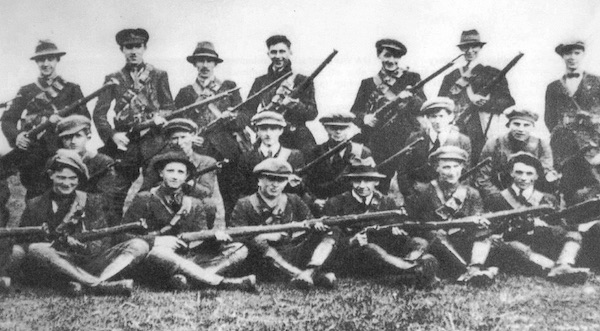
An extract from the Irish War of Independence and the IRA, 1916-1921, by Colm McInerney.
The Volunteers were in great danger of becoming merely a political adjunct to the Sinn Féin organisation. [Sean] Treacy remarked to me that we had enough of being pushed around and getting our men imprisoned while we remained inactive. It was high time that we did a bit of the pushing.
(Dan Breen)
Military operations of the Irish Volunteers remained extremely limited during 1919, although raids for arms began to occur regularly. A shortage of arms curtailed military engagements. In the country ownership of a rifle was often a condition prerequisite to joining a serious operation, and ownership of a revolver was revered in Dublin: “As a Company, we were very poorly armed. If a fellow had a bloody old .45 at that time he was something like Napoleon.”
As a result, obtaining arms was an ongoing obsession. Those who had weapons were most likely to be able to join attacks on British forces. They were also usually the first to join a Flying Column at the end of 1920.
The situation in the country was continuously intensifying. In June, the Freeman’s Journal described the Dublin quays as ‘jammed with tanks, armoured cars, guns, motor lorries and thousands of troops, as if the port was a base of formidable expeditionary force’.
The British army in Ireland was now costing half the total cost of maintaining the army throughout the empire. In September 1919 the Dáil was banned by the Lord Lieutenant, Lord French. This only served to make it easier for the Volunteers to carry out attacks, as their politicians no longer had a public platform from which to restrain them. And it helped Eamon de Valera’s campaign in America, where he was touring to highlight British injustices in Ireland and drum up support for a republic.
In the wake of Volunteer GHQ’s endorsement of open attacks on the Crown Forces, confrontation escalated in 1920. A GHQ policy document proclaimed the smashing of all enemy communications as the main priority.
In the following months, attacks on police barracks became particularly widespread in the South with the acquisition of rifles as its main objective. As a result many isolated undefensible police posts were evacuated throughout the country. This enabled Sinn Féin and the Volunteers, often one and the same outside Dublin, to take over civil control in these areas.
Mass burning of courthouses and evacuated barracks, and raiding of tax offices was ordered by GHQ for Easter 1920. The government’s reaction to the attacks increasingly became coercive, which resulted in the IRA men becoming more determined.
A successful barracks attack became less and less feasible in the course of 1920. Undefensible posts had been abandoned and protection of most other barracks was reinforced. This led to Volunteers attacking police and military targets in a hit-and-run nature.
In response to the rising violence, the British government introduced the Restoration of Order in Ireland Act. This Act, passed 9th August 1920, allowed for internment and court-martial of civilians. This led to the arrest of a large number of Volunteer-officers. As a result of police activity, GHQ ordered all officers everywhere to sleep away from home and to appoint deputies to replace them in case of their arrest. As a result most officers and active men who were not yet on the run, joined the small number of activists that had already left home.
The development towards guerilla warfare in Ireland was still precarious. The small groups of fighting men on the run were extremely vulnerable. Their success could make or break the activity of the Volunteers in a particular district -- losing them often meant the end of operations.
However, public support for the IRA was growing. The arrival of the Black and Tans and the brutality of their tactics drove many to support the Volunteers. The execution of an 18-yr-old medical student, Kevin Barry, for killing a British soldier, and the arrest and subsequent death after hunger strike of the Lord Mayor of Cork, were two more events that made the British position in Ireland ever more untenable.
The relationship between the Volunteers and Dáil Eireann, the Irish Parliament, was quite ambiguous. The Volunteer Convention in 1919 formally recognised the Minister for Defence, Cathal Brugha, as the leader of the Volunteers. The Volunteers at this point became the national army with the title of the IRA (Irish Republican Army). The Volunteers recognised the Dáil as their parliament, and Eamon de Valera as their president, but many IRA men had little time for the politicians.
The Dáil was slow to back a military campaign and was less than wholehearted in its support for the IRA. Many IRA operations were carried out without official sanction from the Dáil, although they were usually sanctioned by the Volunteers GHQ, by men such as Michael Collins and Richard Mulcahy.
A further complication was the position of the IRB in Ireland. Many IRA men were also members of the secret IRB. By 1919 Michael Collins was President of the Supreme Council of the IRB, so effectively these men were sworn to obey his orders. This potential conflict of interest certainly worried the Minister for Defence, Cathal Brugha, who believed that they should see him as their ultimate commander.
In reality, the IRA men looked to the Volunteers GHQ and to their local brigade commanders, rather than to Brugha and the Dáil. However, they always recognised that the Dáil had the ultimate power, but as it was up in Dublin it didn’t affect their day to day running of the war. This paved the way for the spontaneous spread of the IRA’s famous ‘Flying Columns’, and an increase in open conflict.
![[Irish Republican News]](https://republican-news.org/graphics/title_gifs/rn.gif)
![[Irish Republican News]](https://republican-news.org/graphics/title_gifs/harp.gif)

